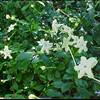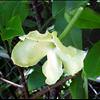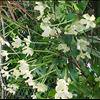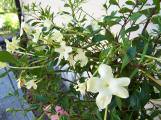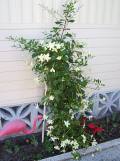This plant may be available to buy
Click the banana to see

|
Lady of the Night click pic to enlarge |
|
Zone 10 or Houseplant The plant in the photo above was grown from seeds of my first Lady of the Night plant sold to me growing in a rusty Campbell's soup can in 1978. The tiny nursery was very out of the way, down a long dirt/sand road in Davie, Florida. The nursery owner was a 'Hippie ' lady and her two beautiful daughters. Nothing in the nursery was labeled so I asked her to show me rare and unusual plants and this was the one she suggested The amazing feature, and the reason for its name, is that after sundown Lady of the Night flowers become wildly fragrant. Within seconds after sundown, the aroma bursts forth from zero to full power. There is absolutely no smell nor hint of aroma in daylight hours. The intoxicating scent goes all night long then stops exactly at sunrise click pics to enlarge To say "fragrant" is totally inadequate because the all the air becomes full of a sweet smell somewhat like a true jasmine but punctuated with strong undertones of cloves, oriental 5-spice powder and cinnamon It is a complex fragrance and very satisfying. Folks offered a "whiff" want to smell it again and again. Conversation immediately turns to discussing this unique aroma. Even our family, which has enjoyed the plant for over 30 years, gets excited to smell the flowers starting every spring because no other fragrance compares click pics to enlarge Lady of the Night is among our family's favorites. Our strain of Lady of the Night grows very upright on thin, flexible woody stems. Imposters have a similar scent, but the plant flops; better suited to hanging baskets. The leaves are dark, leathery, and evergreen. We have never seen any pests on this plant This Brunfelsia americana is listed as a shrub, but really has no such appearance. It is too thin, too delicate to be seen as a common shrub Lady of the Night's habit is mostly wood and dark evergreen leaves with almost no green wood. This Lady of the night grows slowly, straight up with moderate branching. No pruning is ever necessary. Moderate occasional food and moderate water is all that is required. This Lady of the night even handles dry soil well. They are very long lived. We have some 30 years old with only hints of decline Growing small to no more than 4-5 feet in South Florida, in late spring, summer and fall, the flowers appear in cycles; bursts of 3-5 inch long white flowers that turn pale yellow as they age on the stem. Flowers hold for a long time and a happy specimen can show off 100's on any given evening Marion H. sent in the pictures below and said, "I wanted you to see this wonderful bush I bought from you a year and a half ago. So amazing and the fragrance is intense coming through the windows at night. Love It !!!" click pics to enlarge Maximum performance is in the most humid part of summer. The more humid the weather, the more flowers come forth, the further Lady of the Night will be smelled, which can easily be 100 feet away You can cut flower groups off the stem after sundown, take the stem indoors and perfume your whole house. You should take the cutting after dark for maximum aroma although cut during the day, flowers still burst into fragrance indoors after sundown. Visitors always say "what's that I smell?" immediately upon entering our house. Stem placed in water, one cut piece will perfume your home for several days This Lady of the Night enjoys partial shade and wind protection. Lady of the Night does well in ordinary sandy soils, never gets any pests and is a light feeder. Because it blooms well in medium shade, Lady of the Night makes a unique rare houseplant with minimal care. Indoors frequent light misting starting in spring for added humidity is recommended We never see this particular variety for sale anywhere; straight, upright, no droop, uniquely powerfully scented. Every plant show we attend we check for Our Lady of the Night variety; it's never there. The only such upright plants growing we see are ones we have. What a lucky day that was in 1978 when we bought the plant growing in a rusty Campbell's soup can. We take seeds and plant a few every year to make sure they'll never die out Seeds are housed in small green-turning-orange balls. Inside are 2-10 black seeds. Seeds sprout nicely, but slowly Frustrating is that Lady of the Night plants, regardless of size, do not transplant from the landscape to another location; they all die. Digging with a shovel, no matter how carefully, they have never taken to a new landscape location. Started in pots, seedlings re-plant to pots or into the landscape normally. A nice pot is fine as the roots are minimal or direct seed into your land Various Brunfelsia include: |
